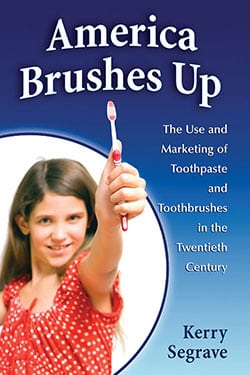America Brushes Up
The Use and Marketing of Toothpaste and Toothbrushes in the Twentieth Century
$29.95
In stock
About the Book
This excursion into American cultural history looks at the toothpaste and toothbrush industries from 1900 to 2008. During these years, America moved from cleaning their teeth mostly with homemade powders to using an enormous array of brands, often applied with an electric toothbrush. From early 20th century products like Forhan’s (which “cured” pyorrhea) to the whiteners of the 1920s (which unfortunately also removed tooth enamel), and from paste that eliminated “that clinging film” and to copywriters who “wondered where the yellow went,” the history of toothpaste has long been a testament to the power of misleading advertising. Interrupting a steady flow of hyperbole was the one true wonder ingredient—fluoride, which enabled Crest to be for decades America’s top-selling brand.
About the Author(s)
Bibliographic Details
Kerry Segrave
Format: softcover (6 x 9)
Pages: 238
Bibliographic Info: 41 photos, notes, bibliography, index
Copyright Date: 2010
pISBN: 978-0-7864-4754-1
eISBN: 978-0-7864-5684-0
Imprint: McFarland
Table of Contents
Preface 1
Introduction 3
1. From Ancient Times to 1899 5
2. Toothbrushes, 1900–1945 15
3. Toothpaste, 1900–1945 34
4. Toothpaste, Advertising and Marketing, 1900–1945 48
5. Toothpaste, Advertising Challenged, 1900–1945 63
6. Toothpaste, 1946–1960 80
7. Toothpaste, Advertising and Marketing, 1946–1960 101
8. Toothpaste, Advertising Challenged, 1946–1960 109
9. Toothbrushes, 1946–2008 117
10. Electric Toothbrushes, 1940s–2008 134
11. Crest Toothpaste, 1960–2008 145
12. Toothpaste, New Wonders, 1960–2008 157
13. Toothpaste, General, 1960–2008 172
14. Toothpaste, Advertising and Marketing, 1960–2008 184
15. Conclusion 202
Chapter Notes 207
Bibliography 217
Index 225





